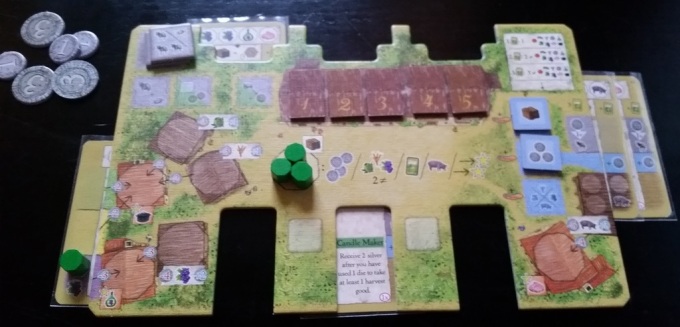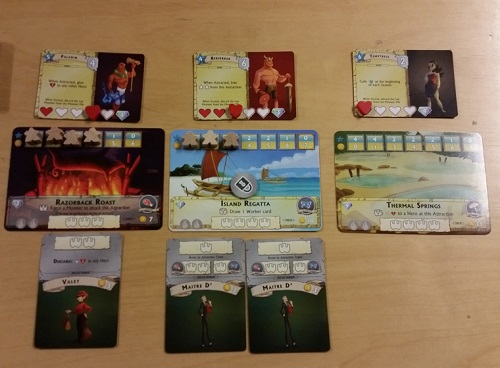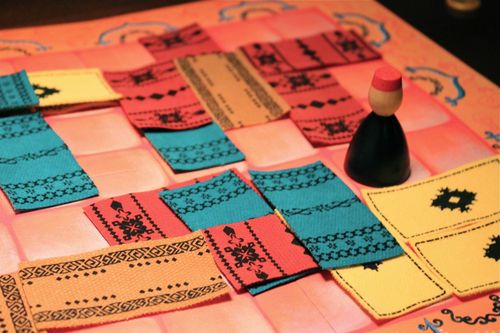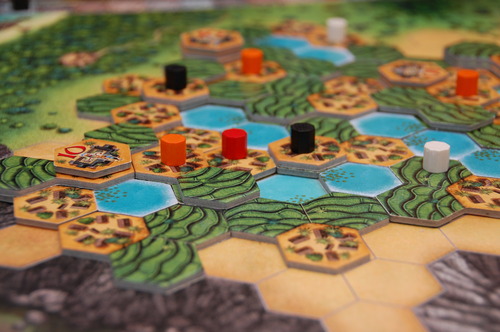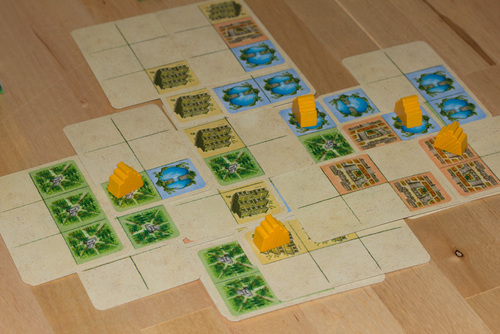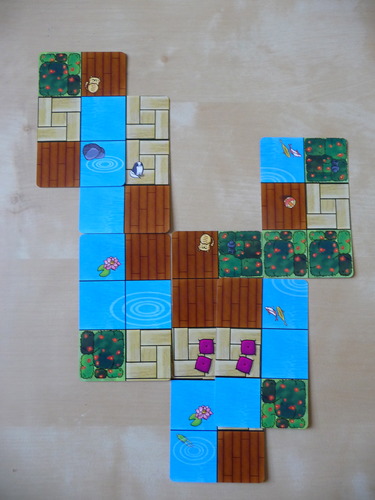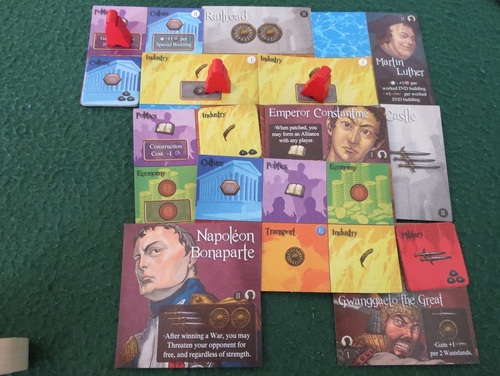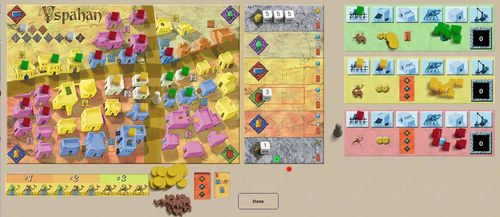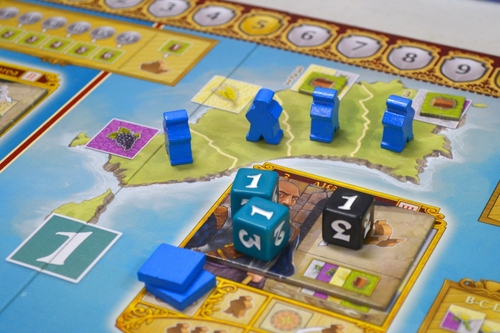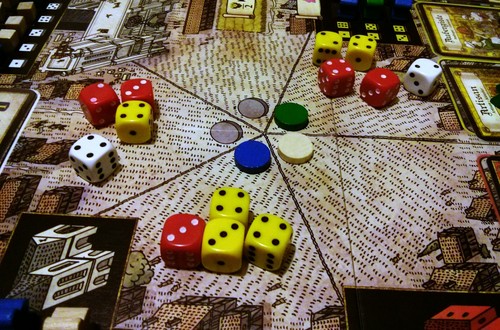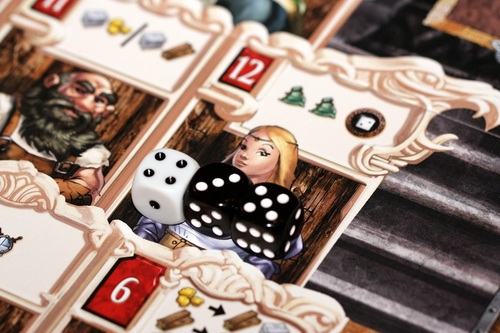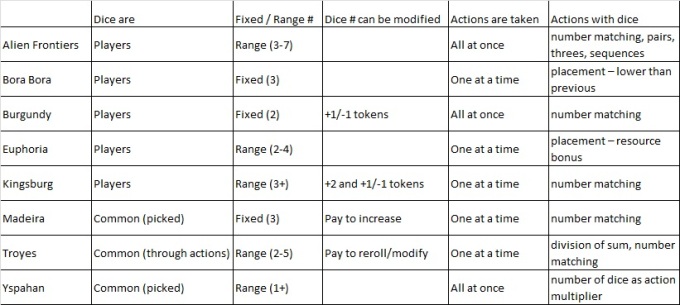La Granja was available at Spiel 2014 in limited quantities from SpielWorxx. I didn’t buy a copy as I knew I could lend it from a friend. After going through all the purchases I made in Spiel I finally could take La Granja in and test it out. This review is based on the first game I played it. It was a four player game that took around 2h with a rule explanation, all first timers with this game.
Overview and components
Like the BGG descriptions says “In La Granja, players control small farms by the Alpich pond near the village of Esporles on the island of Mallorca. Over time, the players develop their farms and deliver goods to the village. Players are vying to earn the title of La Granja for their country estate!”
The game is played over 6 rounds that are divided into 4 phases. Some of the phases can be simultaneously while some are resolved in turn order. So far nothing new or interesting going on here. Farming in euro games has been before. However, just looking through the components made me want to try it out.
More specifically it was the player board. La Granja has multi-use cards that can be used as fields, farm extensions, market barrows, or helpers. If they’re fields they are tucked under the board on the left side, farm extensions on the right side, market barrows on top and helpers in the bottom.Glory to Rome has this same thing but La Granja makes the multi-use more convenient through components.
There are ton of other components all high quality within the box. Each player has 25 markers and there are lots of other tokens to represent silver, victory points and other statuses. The main board is functional and expresses the feel of the game quite well. One thing I have to mention here is that the iconography in the game is solid and really helps the players to play. After the first turn the player aid is everything you need to refresh what is going on. The other things about the components is that the player markers are used in many situations just to mark the owner and the content. So the marker can be a meat resource or a building depending on the location it is. This allows the component number to be smaller than it could be, see Ora et Labora for the other way to do this. I predict that this way of marking stuff is going to be the norm in future games.
Rulebook and set-up
The rulebook is rather big. 18 pages of rules just to play this simple game. Everything is detailed and pictures are great to convey the rules. I just needed one readthru of the rules + skimming while teaching the game to get them right. This might be because I’m used to reading rules and I enjoy going through new games and after 8 years you pick one of two things how games are played. There are a lot of small things that are in play but there are hardly no exceptions so once you go through a turn with your fellow players you know how to play. Playing well is another thing altogether.
The set-up is simple. Give each player their markers, silver, vp, and a player board. Shuffle and deal four cards. In the main board randomize roofs and available craft buildings, place markers on the board and you are set to play.
Playing the game
I’ll just go through the player aid. There are more than this but I engourage to try the game out so you know what the game holds. Let’s start the explanation by saying that in your turn you have a lot of freedom regarding your resources. You can buy, sell or upgrade your resources as long you have the money. You can also use your trade commodities to gain silver/resources/upgrades or play/draw cards. If you have the trade commodities you can really optimize your game. I mention here that upgrading your resources as an anytime action costs silver but if manage to get an upgrade action you get to the upgrades for free. Upgrading your resources is important as almost each card and craft building requires an upgraded resource.
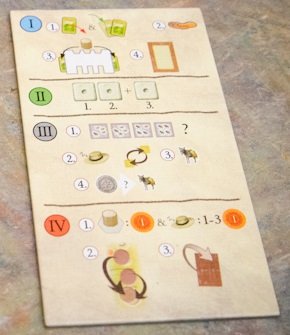 First is Farm phase. First each player can place one card to his own farm and then draw back up to hand limit set by the cards. You start with three and each farm extension increases that by one. Then you take income, this can be resources, trade commodity or money depending on what kind of bonuses you have accumulated. Then cards produce resources, olives, grain, grapes and pigs. Pigs only if you have two pigs in your farm already. These three steps can be taken simultaneously and the last step that is the purchase of roof tiles is taken in turn order. Roof tiles are single use bonuses that additionally bring you points. You can get up to 10 points from them, which is around 1/5 or 1/6 of your points.
First is Farm phase. First each player can place one card to his own farm and then draw back up to hand limit set by the cards. You start with three and each farm extension increases that by one. Then you take income, this can be resources, trade commodity or money depending on what kind of bonuses you have accumulated. Then cards produce resources, olives, grain, grapes and pigs. Pigs only if you have two pigs in your farm already. These three steps can be taken simultaneously and the last step that is the purchase of roof tiles is taken in turn order. Roof tiles are single use bonuses that additionally bring you points. You can get up to 10 points from them, which is around 1/5 or 1/6 of your points.
Then comes the Revenue phase. In this phase dice are rolled. Each player gets to choose two dice in turn order. After you choose your dice you take the action connected to the number. After the two actions tThere is one more dice left in the pool and each player takes that action. The actions are.
- Take a Pig
- Play a card / Draw a card / Take one harvest goods
- Take two different harvest goods
- Take 4 silver
- Upgrade / Move in Siesta Track
- Instant delivery / 2 silver
These actions bring two new things to the explanation that are integral part of the next phase. Transport phase is the third phase. At the start of this phase each player chooses one Donkey marker and simultaneously reveals them. These Donkey marker gives player deliveries and Siesta. The Siesta Track is used to change turn order after the reveal. Add the siesta from the previous phase and player in the highest spot in the Siesta Track immediately becomes the starting player.
The transport phase is where you use a donkey to take a resource marker from your player board to a market barrow (card in your player board) or craft building (one of the six buildings in the main board). If you complete a market barrow you get a trade commodity and place a building on the board, if you complete a craft building row you take a bonus.
The Transport phase is the most dependant on turn order and it is also he phase where majority of your points come from. Turn order is important for two things here. If you are the first player to complete a row in a craft building you gain a bonus, this is a small thing as the bonus is 1-2 points. The more important reason is that the buildings on the main board are taken away if a new higher number building is built by an opponent. So if the first player builds a “6” building all buildings adjacent are safe. However for example iif the last player builds a “6” building the adjacent buildings are taken from the map and they’re extra points for that player. The buildings are the main source of difference making victory points and you don’t want to give the extra to your opponents.
The last phase of the game is Scoring phase. You score each your building on the main board and you score 0-3 victory points from the Siesta Track. The Siesta Track is zeroed and new roof tiles are flipped over. After six rounds all your resources are changed to silver and each 5 silver nets you 1 VP. Most VP wins the game.
Thoughts about the game
La Granja is the BEST new (to me) game I played this year and fights for the spots as the valedictorian of the Spiel ’14 class. Two other contenders being Castles of Mad King Ludwig and Imperial Settlers.
I really got into the game by just looking at the player board. I like the multi-use card system and it is executed very well in this game. We made two errors (we took our own buildings when a higher number was placed adjacent and we didn’t take VP from completing a craft building row) in the whole game with 18 pages of rules. This is all because the clear way the game is represented. The iconography keeps the players on a path and I don’t see many ways that player can get away from that path. This is definately a good thing. The rulebook skimming during the game is far less in this game than some of the more poorly developed games (visually speaking).
The game play is fluent and balanced. The balancing might have gone too far as you get points pretty equally from all actions. The balance is not problem but the feeling that whatever you do each player has gained pretty much points equally. Like I said before the only thing I can think that does not have a balancing thing is placing the buildings on the main board. Thus market barrows rise from all others to be the best way to get ahead. To continue this the VP bonuses (Siesta Track, craft buildings) could have taken away to let the competence of the players to shine. An example of point balancing can be found with the Siesta Track, as the victory points from that track usually relates to the point that you don’t make deliveries to the main board and don’t get many victory points from there thus you get victory points being high on the Siesta track. However, when you get your farm going and can make extra deliveries this balance can be tipped for your favor. The conclusion of this whole points balancing is that the games should end with scores within few points of each other. Somehow I could see enjoying a more wide scoring.
While the art helps to relate to the theme, there is a lack of an ultimate goal in this game. In Agricola you want to build you farm and fill all the spaces you have, In La Granja you just collect points to be the best. There is little relation to your farm and your victory points total in this game. You just go through the game optimizing you strategy. For me this is fine as I’m a mechanics first, play to learn from other designers kind of guy. However, if I was to play this for the theme it would be a let down.
The points that I made above should be taken with a grain of salt as those are my thoughts from one game. I really liked the game and the best thing about this game was that it has a lot of replayability and the feeling that I want to play more. I couldn’t see any winning strategies and there could be many winning plans. The many paths to victory is a key to a good euro game. With many meaningful decisions and a duration that is spot on (under 90 min) this one is a clear winner in my books.
PS. I just had to play this game again with my wife and afterwards she was also happy about playing. I’m sure that I’ll get this one on the table a few times more, which makes me happy.

